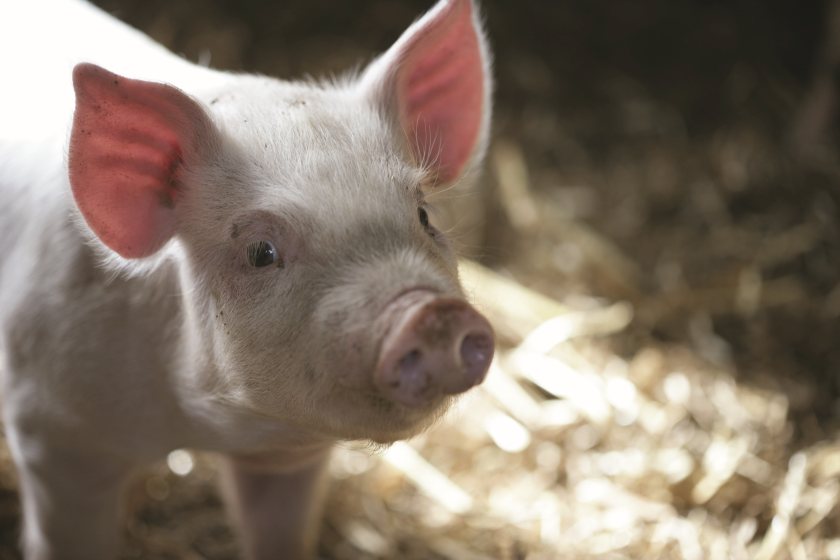
The GB pig market is showing some early signs of seasonal uplift following downward pressure at the start of this year, new analysis shows.
The GB Standard Pig Price (SPP) pig price has been trending relatively stable in February and March.
However, there have been some signs of seasonal increase when the lightest and heaviest pigs are removed from the price reporting sample.
Prices paid for carcases weighing 70-104.9kg have edged higher in five of the last six weeks, rising 0.4% from a year-to-date low of 212.55p/kg to reach 213.43p/kg in the week ending March 23.
Quality Meat Scotland (QMS) says that despite evidence of a slight seasonal upturn, prices have still slipped behind year-earlier levels for the first time in two years.
Still, they were up 35% on their five-year average in mid-March, reflecting the sharp market rebound between spring 2022 and 2023.
Pig producers will be relieved that the price of feed has been falling. Defra’s animal feed price series shows that grain prices in January were down 25-30% on 2023 levels.
Protein meal prices have also fallen sharply since a brief rebound in autumn 2023, taking them down over 20% on the year.
Since then, market data suggests that there has been further downwards pressure on both grain and protein meals, although grain prices have rebounded slightly in the second half of March.
QMS market intelligence manager, Iain Macdonald says: “These trends reflect a well-supplied global arable crop market, supported by factors such as an improvement in Ukraine’s export capacity and favourable growing weather in South America.
“A stronger sterling against the US dollar than in early 2023 has also helped.”
Although wages have been rising quickly and energy and borrowing costs remain elevated, the current balance between production costs and output prices suggests that pig producers’ finances are slowly recovering from the financial crisis of 2021/22.
“However, given the scale of that crisis, there’s still a long way to go,” Mr Macdonald explains.
Defra slaughter data showed an 11% decline in prime pig throughput at GB abattoirs in 2023 and the trend continued at the start of 2024, down another 4% in the first two months.
While December pig census results are not available for Scotland, England’s results show that finishing pig numbers were still down by 11% year-on-year, and by 18% on the peak reached two years before.
“Sow numbers in England did show a marginal rebound in December 2023, but they were still 19% lower than in December 2021.
"So, while there could be some recovery in the second half, there is little room for any significant rebound in prime pig slaughter in England in 2024,” Mr Macdonald says.
Given the sharp reduction in domestic pork production since 2022, the external trade balance has been supporting availability for consumption.
UK export volumes fell by nearly a quarter in 2023 and while imports fell slightly in the year as a whole, they were higher than in 2022 between April and the year-end.
Mr Macdonald says higher import volumes have been supporting market supplies for nearly a year, and import prices tend to closely follow trends in EU pig prices.
He says: “After six months trading at a small discount of only around 5% to GB levels, EU pigs became relatively cheap in the second half of 2023 and the price gap widened beyond 20% in early 2024.
"However, there has been a strong seasonal rebound in the EU since February, and the price gap dipped to 13% in the third week of March.”
While EU pork remains competitive, it is not as cheap as it looked over the winter, and EU supply remains fundamentally tight.
“Although there was some recovery in the EU sow herd in December 2023, numbers were still 7% below pre-covid levels,” Mr Macdonald explains.
“In addition, fattening pigs were still showing a year-on-year decline of 2.4%, highlighting that, like at home, any recovery in EU pork production is likely to be weak.
"As a result, the downwards pressure on the domestic market from EU imports is likely to remain limited.”
Looking further afield, he notes that the USDA is expecting increased global trade this year, with a key driver being China.
China’s pork production rose sharply late last year as loss-making producers liquidated herds.
As a result, numbers are expected to tighten in 2024, resulting in higher import requirements once stocks built up in 2023 have been used up.
Although pork prices have dipped seasonally since Chinese New Year, wholesale prices continue to look relatively attractive, holding above GB farmgate price levels, and the Chinese market has often risen between spring and autumn.
By 2023, UK exports to China had fallen back to around where they had been before China’s severe pork shortage of 2019 and 2020.
However, at a share of 36%, they made up a significantly higher proportion of UK exports than in the pre-African swine fever period, highlighting China’s position as a vital market outlet for processors looking to achieve carcase balance.
